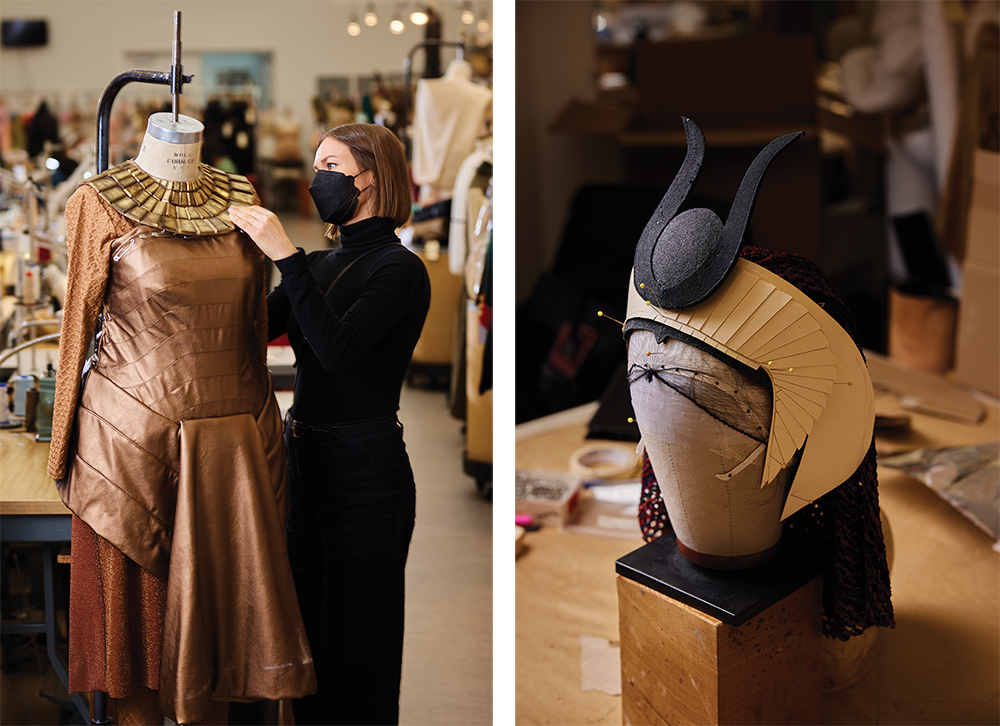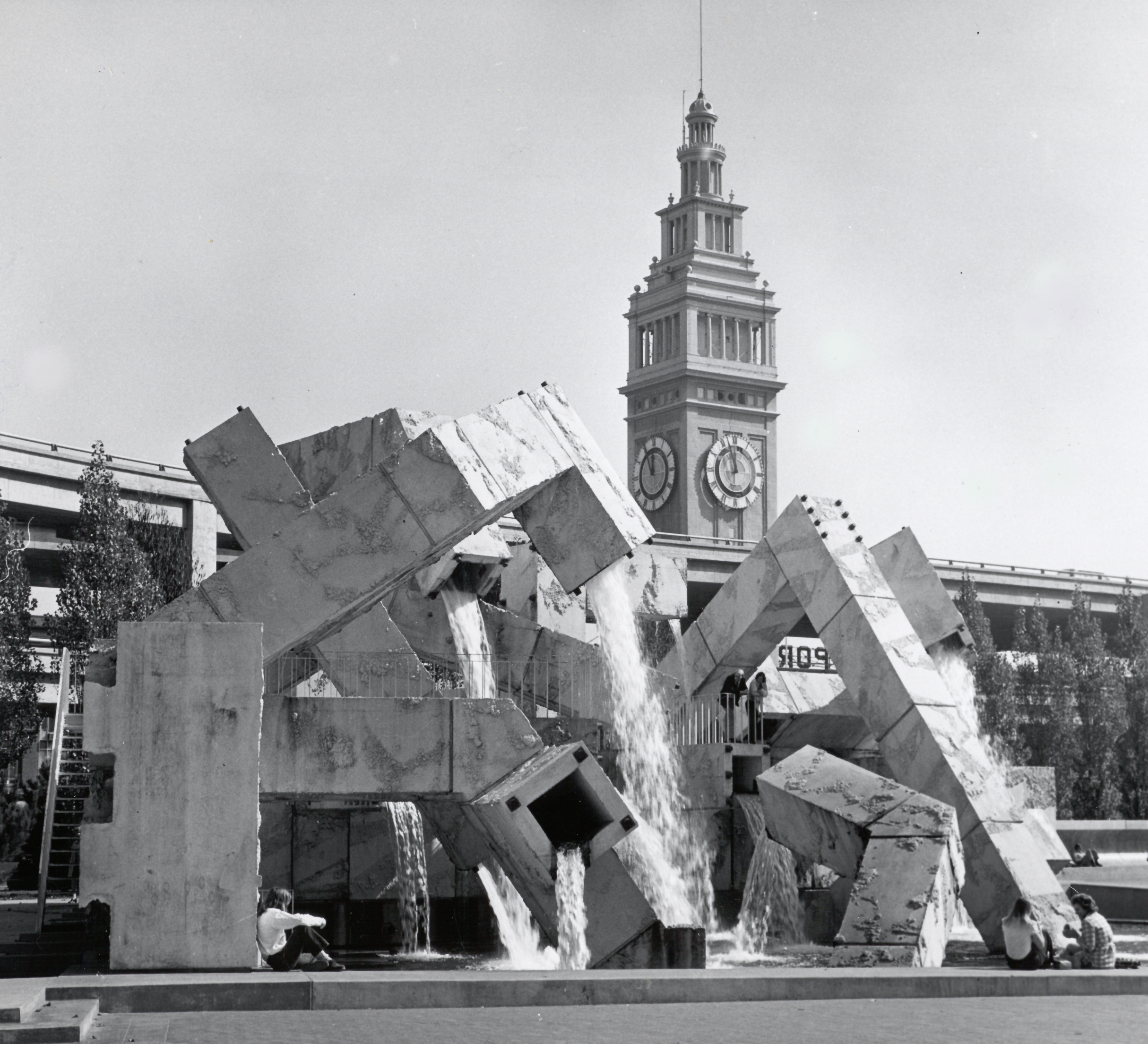
Behind the Scenes of the San Francisco Opera
By Jean Schiffman
As the curtain rises on San Francisco Opera's Centennial Season, SF/Arts writer Jean Schiffman explores some of the nuts and bolts involved in the company's high-end production and design.
On a midweek morning, the San Francisco Opera costume shop is a colorful wonderland of dressmaker’s dummies, quietly humming sewing machines, ironing boards, bolts of fabric, racks of frilly gowns, ceiling-high shelves of boxes with handwritten labels — “felt skullcaps,” “moulded leather breastplate with leg flaps”— workers bent over cutting tables. The Opera purchases only modern costumes; the rest are built here, in this long, sky-lit room in the Veterans Building.
It is approaching the September 10 opening of the Opera’s triumphant centennial season — 90 years in the Opera House itself — with the world premiere of internationally renowned Bay Area-based composer John Adams’ “Antony and Cleopatra.” Adams adapted the libretto from Shakespeare with some text from Plutarch, Virgil and other classical works in consultation with director Elkhanah Pulitzer and dramaturg Lucia Scheckner. The opera is a co-commission/co-production among San Francisco Opera, Liceu Opera Barcelona, Teatro Massimo di Palermo and the Metropolitan Opera.
The glitter that represents Roman and Egyptian royalty lights up the shop: Antony’s golden headpiece with long golden curls attached; Caesar’s signature laurel wreath resting casually on a table-top; Cleopatra’s shimmery-blue, form-fitting gown for floating on the barge and lounging by the pool; a necklace of metallic-looking tiles (two dozen such necklaces, made of plastic, are sent off-site to be created on a 3-D printer for Caesar’s all-women army). The shop crew of 44, which includes a costume director, a senior production supervisor and a senior milliner, has been working on “Antony” since January.

Preparations for the world premiere of John Adams’ "Antony and Cleopatra." Left: Galen Till, Senior Costume Production Supervisor at San Francisco Opera, inspects a sample collar on one of Cleopatra's Soldiers. Right: The mock-up (working sample) of Cleopatra headdress. Courtesy San Francisco Opera. Photographs by Hardy Wilson for Drew Altizer Photography.
Behind the scenes, both the costume shop and the scene shop have been busily building all five operas for the season, which includes, in order, Pyotr Ilyich Tchaikovsky’s “Eugene Onegin,” Francis Poulenc’s “Dialogues of the Carmelites” and new productions of Giuseppe Verdi’s “La Traviata” (that set was finished end of last year) and Christoph Willibald Gluck’s “Orpheus and Eurydice.”
The set for “Antony and Cleopatra” was challenging for New York designer Mimi Lien and the production’s director, Elkhanah Pulitzer. The artistic team, based in New York and here, came together in March 2020, and then: pandemic. Zoom meetings commenced to discuss the production’s concept.
And it’s a layered concept. The opera blends three time periods: the actual era in which the titular rulers lived (the queen of the Ptolemaic Kingdom of Egypt reigned from 51 to 30 BCE); the era of 1930s Hollywood film glamor; and our own age of self-made icons. How to represent those three periods in the set design was a challenge Lien, whose background is in architecture and who designs for theater and dance as well as opera, eagerly accepted.
The team explored the complexity of the characters — John Adams perceived the love between the two rulers to be a mature love; they were strategically sharp political figures. “Because our focus was on the different representations of Cleopatra through the media, and specifically filmic representation, I first watched films,” Lien says. Then she moved to primary source research, looking at Egyptian and Roman architecture and film set versions of Egypt and Rome. How do we in our mass-produced culture represent these monolithic societies of the past? she asked.
But Lien had much to draw on; she’d lived in Italy for nine months and was able to envision “the stones, the color, the way the sun hits the stone . . .” Still, she pondered how to connect three time periods: Before the Current Era, the artifice of 1930s movies and our own times. How is all that manifested in the physical world? The scale had to be big enough for the Opera House; the stage’s proscenium is 52 feet wide, the ceiling 32 feet high. “There’s a grandeur to the way Egypt and Rome are represented in films,” she explains, “an epic sweep.” The scene shop ceiling is only 18 feet high; set pieces must be built in sections for loading in.

San Francisco Opera Scene Shop foreman John Del Bono and colleagues work on the set for November's "Orpheus and Eurydice," where the 50-foot spinning polystyrene dome will feature center stage. Image Courtesy San Francisco Opera. © 2022 Drew Altizer Photography.
Ultimately Lien designed a structure with Egypt on one side and Rome on the other, set on a turntable, asking herself how the turntable should move. Horizontally? Vertically? Do pieces slide, or fly from above or below from the trap? Fast or slow? (The answer: glacially slow.) What is the texture — realistic or abstracted?
As an Asian American, Lien spent time thinking about the exotification of such women as Cleopatra over the eons, and how we depict the construction of a media image. In early Hollywood, Cleopatra was played by white women. In this production, the role is played by Egyptian/New Zealand lyric soprano Amina Edris.
Costuming Cleopatra was indeed a special challenge for frequent San Francisco Opera costume designer, Constance Hoffman, based in New York. “Any time we take on the character of Cleopatra, there’s such a fetish around her image,” she says, adding, “The Shakespeare play is a beautiful examination of a relationship between two mature, intelligent, complicated human beings.” That relationship was fascinating to an Elizabethan audience, she says, and remains fascinating to us.
Hoffman was tasked with bringing the imaginative journey up to the present. “We found 1930s Hollywood to be a time when movie stars were like gods and goddesses,” she explains. “That moment in time kind of crystalized the level of glamor that Antony and Cleopatra held. In our own time we can look at how we deify celebrities.” Research into the different eras began even before John Adams had finished the opera.
For Hoffman, this has been a dream job, to work on a world premiere such as this, and to give the pharaoh “nuance, brains, integrity. . . . [to integrate] not just her sexuality but her full range of powers.” Besides, she notes, “You don’t often get Shakespeare as your librettist!”
One obstacle: sourcing fabric. The market was hard hit by the pandemic, with supply chains in disarray. The design team had to start over several times in selecting fabrics, sometimes going to second and third choices.
Unlike the quiet ambiance of the costume shop, the scene shop rings with country music, mingling with the hum of machinery (the background soundscore changes daily, peaking on Fridays with heavy metal). On this day, the crew of a couple of dozen machinists, carpenters, painters and builders is constructing Rome; Egypt is almost ready to be shipped to the Opera House.
“We haven’t built a one-off show in a long time,” says shop foreman John Del Bono. “In the ’80s and ’90s, none were built. But we’re building legacy shows from now on, which is great!” Sets are stored in a warehouse in Modesto.
At the center of the scene shop is a polystyrene dome, 50 feet in diameter, that will spin and take up most of the stage, leaving 10 feet on either side. It is for the short opera “Orpheus and Eurydice,” sung in Italian with supertitles, to open November 15. First performed in 1762 and only staged once by SF Opera, in 1959, it tells the tragic myth of Orpheus (countertenor Jakub Józef Orliński), permitted by the gods to seek his wife, Eurydice, in the underworld — if he abides by the rules.
Dancers will dance atop the dome, and on either side. “It represents a liminal space between Hades and the world,” explains Del Bono. He brainstormed with the technical director, staff mechanics and director Matthew Ozawa to realize Bay Area Alexander V. Nichols’ design.
For frequent SF Opera designer Nichols, the job was a tough one, because he was asked to basically re-imagine the set he designed for “Fidelio” last October in order to make a cost-effective “Orpheus” set. “It seemed like such an odd pair, to put together ‘Orpheus’ and ‘Fidelio,’” Nichols says, “they’re such different animals.” It ended up that the whole motorization of the “Orpheus” dome comprises imperceptible bits and pieces of the “Fidelio” turntable system. “It was a difficult process,” he admits. “I wanted something completely different from “Fidelio,” more poetic and atmospheric, for a delicate opera.” His final ideas included projections of brain images from UCSF that represent emotional states, a depiction of Orpheus’s grief). Along the way, he and choreographer Rena Butler had long conversations about what sort of surface the dancers needed on the dome. When it's in motion, Nichols says, “It will cause an imbalanced world, continually changing perspective."
Would he have created that same set if he hadn't had to repurpose
the “Fidelio” set? “I’ll never know,” he muses. “Creativity works wonders in
various ways.”
→ San Francisco Opera 2022/2023 Season begins September 9 - sfopera.com
Main image: Love (Amore) costume sketch for San Francisco Opera’s new production of Christoph Willibald Gluck’s "Orpheus and Eurydice," opening November 15. Image credit: Jessica Jahn, costume design and Dan Wang, illustration.
**correction: This story ran in the September/October print edition of SF/Arts and we would like to take this opportunity to correct a mistake therein. New York designer Mimi Lien and the production’s director, Elkhanah Pulitzer are not married to each other, as was stated in that article.



